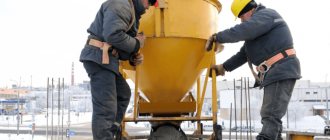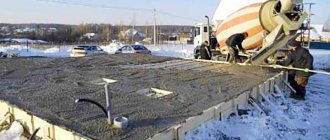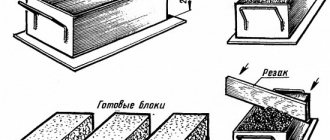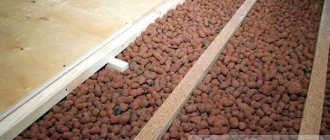Oh, the issue of laying asphalt on roads both in rain and snow, in autumn and winter, causes a lot of controversy. Let's clarify the obvious, understand the norms, but first let's study the terms.
Asphalt concrete mixture is a rationally selected mixture of mineral materials with organic binder, taken in certain proportions and mixed in a heated state.
Figuratively speaking, just as a bun is made from flour, so from an asphalt concrete mixture – asphalt concrete, or a compacted asphalt concrete mixture in a layer of a road structure.
Depending on the laying temperature, mixtures and asphalt concrete are divided into the following types:
- hot – with a laying temperature of at least 120°C;
- warm – with a laying temperature of at least 80°C.
Preparation and delivery
Asphalt concrete mixtures are usually prepared at an asphalt concrete plant (ACB) and then unloaded into a storage bin or directly into trucks.
Almost every administrative region of our country has such a plant, and in medium-sized and large cities there is more than one. “Minus” temperatures noticeably affect the operation of the asphalt plant, so in the harsh winter they mainly carry out preventive maintenance and repair of various components and assemblies.
The mixtures are delivered to the installation site by transport. For transportation distances of more than 20 km, dump trucks equipped with awnings or other means are used to prevent the mixture from cooling down. Depending on how long the temperature required for installation can be maintained, the duration of transportation is calculated.
Laying
Before starting work on laying the asphalt concrete layer of road pavement in winter, the bottom layer (let’s take it as a given that all preparatory work has been done correctly) must be cleared of snow and ice.
Coatings and bases made from asphalt concrete mixtures are made in dry weather.
No precipitation, dry weather, mostly no precipitation - no precipitation or the amount of liquid and mixed precipitation ≤ 0.2 mm in 12 hours, the amount of solid precipitation ≤ 0.1 mm in 12 hours (meteorological dictionary, Belhydromet).
During snowfall and blizzards, work on the construction of road surfaces is not allowed.
Laying of hot and cold mixtures should be carried out at an ambient temperature of not lower than +5°C, vibratory-cast mixtures - not lower than +15°C, warm mixtures, as well as hot mixtures with temperature-lowering additives - at a temperature not lower than minus -10°C.
By the way, visually warm asphalt concrete, hot asphalt concrete or hot asphalt concrete with temperature-lowering additives do not differ from each other.
It is allowed to carry out work using hot asphalt concrete mixtures at an air temperature not lower than 0°C, as well as hot mixtures with temperature-lowering additives at an air temperature not lower than minus -10°C, subject to the following requirements:
- the thickness of the layer being arranged must be at least 5 cm;
- it is necessary to use asphalt concrete mixtures with adhesive additives or activated mineral powders;
- The top layer should only be placed on the freshly laid bottom layer or on the leveling layer until they cool down (while maintaining the temperature of the underlying layer at least +20°C).
The consequences of violating the laying temperature conditions are obvious - the mixture cools quickly, which leads to a significant deterioration in the quality of the created road surface.
Laying of cold asphalt concrete mixtures (with certain exceptions) should be completed approximately 15 days before the start of the autumn rainy period.
If vehicles will move on the asphalt concrete layer in winter or spring, it should be constructed from dense asphalt concrete mixtures.
Before laying the mixture, the surface of the lower layer of asphalt concrete pavement, cleared of dust and dirt (snow and ice), is treated with bitumen emulsion or bitumen. Treatment of the bottom layer with a binder may not be carried out if the time interval between the installation of the upper and lower layers is no more than 2 days and there is no movement of construction vehicles.
Laying of asphalt concrete mixtures is carried out with an asphalt paver and, as a rule, over the entire width of the pavement. In exceptional cases, on local roads, it is allowed to lay mixtures in the lower layer of the surface and in the base using a motor grader. In places inaccessible to the asphalt paver, manual laying of the mixture is allowed.
Obvious and incredible
Conclusions. Still, “winter” asphalt concrete does not exist. But if we take the “lower” limit of the standards, then the asphalt concrete pavement (namely the coating, and not the repair of potholes, which can be done down to minus -20°C) can be laid in dry weather at an ambient temperature down to minus -10°C with the fulfillment of the specified conditions. In this case, the underlying layer must be cleared of snow and ice, and work cannot be performed at all during snowfall and blizzard conditions.
Despite all the obvious, many have probably seen the incredible.
Technology for laying asphalt at sub-zero temperatures
In Russia there is snow for 6-7 months, and roads need repairs regardless of the time of year. The technology of laying asphalt in winter using cast asphalt allows you to lay asphalt on snow and in rainy weather. The mixture includes sand, ground limestone, gravel and natural bitumen. When the operating temperature is 180 degrees Celsius, the molded asphalt takes the form of a hot, black plastic mass. The production technology of such material uses rubber and cellulose, which improves the quality of the product.
Laying asphalt in winter, building codes and regulations provide for the use of various plasticizers and hardeners. The agents are used to ensure that the mixture does not freeze at high sub-zero temperatures and has increased fluidity. This method allows you to seal holes when they contain dirt, water, snow, and ice. Lay asphalt at sub-zero temperatures using cold mixtures. This technology for laying asphalt in rain and snow is widely used in such areas of application as spot repairs of highways and highways.
When can installation be done?
Cold asphalt has one significant advantage over hot asphalt: it can be laid in any weather and sub-zero temperatures. Typically, mixtures are recommended to be used down to -5°C. But there are varieties that can be laid even at -15°C. This is possible thanks to the plasticizers added to them. It is advisable that the surface of the pit be dry during repairs. Therefore, it is recommended to choose sunny weather for work. If repairs need to be done urgently, the wet bottom and walls can be easily dried with a regular hair dryer. On the other hand, cold asphalt can also be laid during rain and in a hole with some water. Of course, in this case, the adhesion of the asphalt to the walls of the pit is worse, and the service life of the coating is reduced. But this is also an acceptable option, and a little moisture is not a problem. Detailed instructions for repairing potholes with cold asphalt mixture are described below.
Hot casting
Cast asphalt in winter differs from the standard mixture in that it contains solid bitumen, which has increased viscosity, and mineral inclusions - sand, finely structured crushed stone. Work with hot mixtures is carried out at a temperature of 200 C. Thanks to this technology, road patching can be done by laying asphalt on snow. The building material costs less than cold mixtures. Cast asphalt is easier to lay in winter due to its good plasticity. During the summer, this technique is considered a temporary emergency repair.
If we draw an analogy with ordinary hot asphalt, cast asphalt has the following positive and negative qualities:
Advantages
- After the mixture is poured, it compacts on its own when it hardens, no rolling with an asphalt roller is required;
- When testing asphalt concrete for frost resistance, it is the cast mixtures that have exceptional adhesive properties and are able to form strong adhesion to the base at sub-zero temperatures, high humidity and precipitation.
Flaws
- In order to transport a hot mixture, you will need expensive equipment that will maintain the temperature at a high level and constantly mix the material;
- Repair work on cast asphalt in winter requires considerable energy expenditure. The operating temperature during installation should be at least 200 degrees Celsius.
Installation materials
You don't need a lot of materials to repair potholes in your yard or on your driveway. So, if the depth of the hole is up to 20 cm, you will not need anything other than cold asphalt. If the pothole depth exceeds 20 cm, you can additionally purchase:
- Crushed stone
- Bitumen
Next we will briefly explain what these materials are and why they are needed.
Crushed stone
It is needed to fill the bottom of the hole and save money on rather expensive cold asphalt. In addition, crushed stone provides better adhesion between the asphalt and the base and gives strength to the repaired surface. Thanks to the crushed stone cushion, the asphalt will not sag under pressure. Please note that crushed stone can consist of grains of different sizes. Some large rocks may even exceed the size of your hole. Therefore, be sure to pay special attention to the fraction of the material. The best option for filling the hole would be crushed stone with a grain size of up to 40 mm.
These may be factions:
- 5-10
- 5-20
- 5-25
- 10-20
- 20-40
In this case, you can combine different fractions, filling the voids between large stones with smaller ones (that is, doing clinching). As for the rock, we advise you to opt for inexpensive materials: granite or crushed limestone. After all, it makes no sense to buy expensive types for pothole repair. But, of course, you can take other types of crushed stone (diorite, serpentinite, amphibolite and others). The only thing is to take into account the strength of the material (it is designated by the letter “M”). Ideally, it should be from M600 (medium strength) and higher. Then the material will be able to withstand sufficient loads.
Bitumen
The binder component is usually used in the repair of federal highways and highways with high traffic. It is needed for better adhesion of asphalt to the lower layers of the coating, the bottom and edges of the pit.
It is better to choose slow-thickening (MG), partially oxidized (MGO) or medium-thickening (SG) brands:
- MGO 70/130
- SG 40/70
- MGO 130/200
The numbers indicate possible viscosity ranges. They are determined in laboratory conditions by the degree of penetration of a thin needle into the mass of material. In southern latitudes it is better to use materials with a small viscosity range (for example, 40/70); for northern latitudes, MGO 130/20 grades are more suitable, and in temperate latitudes - 70/130. Bitumen can be replaced with an emulsion. Water is added to it with emulsifiers, which slow down the separation of bitumen and H2O molecules. Bitumen emulsion is convenient to spray and apply to the surface, it is non-flammable, can be used at low temperatures, and has better adhesive properties. Impregnation can also be done with tar (an oil refining product). It is recommended to use it to save money when processing the walls of small pits.
Cold asphalt
This is the most important material, which, by and large, can be used independently, without improvised means. Unlike hot asphalt concrete, cold asphalt contains less bitumen (4-6%). Its viscosity is low or medium. The material hardens due to the evaporation of carbohydrate compounds from its surface.
Cold asphalt can be fine-grained (mineral particles up to 20 mm) and sandy (up to 5 mm). The first option is more durable and suitable for patching roads, parking lots, and sidewalks. The second can even be used to level the surface and backfill small areas.
In the next part we will tell you under what conditions it is allowed to lay the material.
Mistakes that should not be made when laying asphalt in winter
There are cases when the installation technology during the cold season was not followed. In the spring, the following happens: a perfectly flat surface, after heavy equipment passes over it, turns into a bumpy road with cracks and holes. Here's what you absolutely shouldn't do when laying a road surface in winter:
- A cushion of crushed stone with sand will be equal to laying asphalt on the ground.
- Even if the pillow is well compacted during the cold season, fragments of frozen sand, snow, and ice will still remain there.
- When ground ice begins to melt in the spring, the formed cushion begins to become severely deformed. As a result, cracks and deep holes form.
How long can asphalt last?
The service life of a road deck directly depends on the loads placed on it, the intensity of vehicle traffic, and weather conditions. It depends on whether the installation work was carried out in accordance with the technology and what materials were used. The average service life of a road surface is 7-10 years. But it is worth considering that in case of high operating load this period may decrease. Regular repair of the asphalt area, which involves eliminating cracks, potholes, and deformations, can extend the service life.
To ensure a long period of operation of the coating, it is advisable to follow several tips:
- Do not allow heavy tracked vehicles to enter the asphalt area, in particular this applies to tracked tractors;
- in the summer, the asphalt area heats up significantly and under heavy weight it can easily deform;
- the coating needs periodic maintenance and inspection - if any cracks or defects appear, repairs should be carried out immediately, since in the opposite situation, holes and potholes will only become larger, which can provoke accidents.
In addition, the longevity of operation is greatly influenced by high-quality turnkey asphalt laying.
. For this reason, the task should be entrusted to experienced specialists.
Bottom line
Roads can be repaired in winter using cast asphalt concrete. The material is reliable and durable compared to cold mixture. But the use of cold asphalt is a modern and suitable method for pothole repair in winter. The formula is constantly being improved, which in the near future will make it possible to effectively repair emergency sections of the road at low temperatures.
(1 rating, average 5 out of 5)
Source
Very often people ask this question: Is laying asphalt in winter conditions normal or is it a violation?
The authorities of different cities also cannot come to a common decision.
In some places it is allowed to lay asphalt in winter conditions, and in some places, like in Bashkortostan, the head of the republic by order banned the laying of asphalt in winter conditions.
In some places it is allowed to lay asphalt in winter conditions, and in some places, like in Bashkortostan, the head of the republic by order banned the laying of asphalt in winter conditions.
The asphalt hysterics of active citizens are moving to another plane.
From the questions “Where did the good asphalt go” and “Why doesn’t anyone fill the holes”, they suddenly turned to the question “Why do you fill the holes if everything will fall off anyway”?
To the question why our asphalt is bad, I already answered in the article “Do you know why Papuans don’t build skyscrapers?” and the topic was closed.
You (we) won’t have good asphalt in the next three years, that’s all.
Now about pothole repair.
What is being done now is a last resort. In conditions of budget deficit, pothole repair is the only way to quickly and effectively solve an “unexpected problem.”
I will answer the main questions:
In frosts down to -10C, cast asphalt can be laid. There is a technological map, there are regulations and a conclusion from specialists.
In Ufa, “cast asphalt” has been laid since March 11.
10 five-cc cars are rolled out per day in Chernikovka alone.
It is this brand of mixture that can be placed on a damp surface.
YES! CAN.
Here is a video in which I tell you how the asphalt was laid and what it looks like after a year.
Today is autumn 2022. The situation has not changed.
I've only heard good things about cast asphalt. There are no secret formulas there. More quality bitumen and more powders, plus additives.
Naturally, it becomes more expensive, plus its delivery is more expensive, since it must be delivered to the work site at the correct temperature. Plus the cost of heating the surface being repaired.
True, you can save on a stacker and less qualified labor. but these little things will not cover the cost of the material.
Let me sum it up.
If you do everything humanely, it will turn out fine. Not great, but ok. We have no other ways to quickly solve a serious problem.
Watch the video and draw your own conclusions
That's it. Smart people watch videos, busy people go to sleep or work, and fools and active citizens go to sign petitions.
Touch the asphalt that was laid in winter and has been standing for almost three years. you can here:
Read and don't say you haven't read.
Now regarding the order of the Head of Bashkortostan banning the laying of asphalt in winter.
Is the order correct or not?
I think it's correct. In winter, you can do pothole repairs.
It is possible and necessary. Don't build roads and lay ABS, but repair them.
But this should be done by professionals with special equipment and according to the technological map.
How can we control that the work is being carried out according to the regulations? NO WAY,
Therefore, it is easier to ban everyone. And there won't be any headaches.
Let them lay down during the warm season.
Any super specialist who reads this text will make me a lot of comments. It will definitely remind me that this is not asphalt, but an asphalt-concrete mixture. He will tell you about adhesion, declinging and will definitely call the road a roadbed. I deliberately changed the terms so that everyone would understand.
Why we won’t have good roads for a long time, I told you here: https://kabzon.livejournal.com/145299.html
Source
The temperature of asphalt during laying primarily depends on the type of asphalt concrete used. Also, the type of asphalt mixture determines the scope and temperature range of asphalt heating required for asphalt paving work.
“If an asphalt concrete mixture contains a lot of crushed stone from durable rocks, its strength and rigidity increase, as a result of which the mixture is heated more before placement to ensure sufficient plasticity necessary for high-quality compaction.”
Laying asphalt, carried out in accordance with asphalt paving technology, requires mandatory adherence to temperature conditions, as this directly affects the quality of the road surface.
The following main types of asphalt concrete are distinguished, differing in temperature during installation:
- hot;
- cast;
- cold.
Each variety has its own temperature ranges that are permissible during work. The temperature of the asphalt during laying also increases depending on the percentage of crushed stone or gravel.
Carrying out road work by season
Let's divide road work into seasons.
Carrying out road work by season
Summer season
As a rule, during this season, planned work is carried out to repair road surfaces that need medium or major repairs, defects are eliminated, new shoulders are planned, and the road area is cleared of dust. There is also a current type of repair. Its essence is that minor damage to the road surface and earthen embankment is eliminated.
Repairs of medium complexity are usually carried out no more than once every few years. This is done on separate sections of roads. Thanks to such repairs, the damaged top road layer is restored or a new one is laid.
The laying technology itself and the road surface material have been improved over the years. When restoration work has been carried out on the surface, asphalt concrete is placed on top to thicken it. Reclaimed pavements are made heavier and thicker during the laying process using gravel or crushed stone that is treated with binders. To eliminate potholes on transitional surfaces, gravel or similar materials are also used, but without the use of binders.
Major damage is repaired periodically. When carrying out such work, the road is strengthened. The road is being maintained in accordance with the standards.
Autumn season
The road surface is being prepared for winter. For preventive purposes, roads are strengthened to prevent deformation due to frost. clear crossings and exits to main highways from dirt roads. To prevent snow from getting into the pipes, they are covered with shields. Crushed stone and similar natural materials, including soil, are used to eliminate ruts on roads and level out bumps. Mobile snow protection devices, such as stakes, are installed in places where the snow protection line is expected.
Winter season
The main goal of this season is to remove snow from the streets and combat icing on the roads. At the same time, materials for summer maintenance are being prepared. When there is too much snow on the roads, driving by car becomes problematic, and in some cases it can simply be stopped.
Potholes pose a big threat on the roads. Their formation occurs during heavy snowfalls and blizzards, when road equipment does not have time to compact the snow in an even layer and dense deposits form on the snow.
Spring season
All road equipment is aimed at clearing roads of remaining ice and dirt. Roadsides are cleared of snow. Storm pipes are opened and cleared. It is also very important to eliminate, or better yet prevent, the consequences of floods in a timely manner. With the help of coordinated actions of road services and aviation, it is possible to identify in time those places where too much ice accumulates, and thereby avoid floods.
Particular attention is paid to work that helps preserve the road surface from deformation. Using special equipment (motor graders, mechanized brushes), the road surface and roadsides are cleared of ice, accumulated mud and snow. After the main work is completed, the motor grader brings the roadsides into proper shape.
At what temperature is hot asphalt laid?
Hot asphalt is the most popular material for constructing durable pavements, as it is of high quality. Asphalting with materials from this group is carried out from late spring to early autumn (at temperatures from +5°C), since in cold weather cooling will occur too quickly.
– The average temperature of asphalt during laying (for hot mixes) is 120°C.
At what temperature is poured asphalt laid?
Cast asphalt concrete is a hot mix asphalt and therefore requires heating before installation. The use of this material, like other hot mixtures, is allowed in warm seasons at air temperatures from +5°C.
- The average temperature of asphalt during laying (for cast hot mixes) is 220°C.
- Depending on weather and technological conditions, as well as on the composition of the mixture, heating before installation has a temperature range from 185 to 250°C.
A special feature of cast asphalt is that there is no need for compaction, since the mixture independently gains strength as it cools. Therefore, this type of asphalt must be heated before laying with a smaller margin than conventional hot asphalt concrete.
How long does it take for asphalt to dry after it is laid?
It is advisable not to touch fresh asphalt after laying.
- two days!
Minimum - 8 hours. Therefore, road workers must install a special sign so that no one can drive on fresh asphalt
. It also depends on the temperature; the hotter it is outside, the longer it takes to freeze.
Interesting materials:
How to change location on Android? How to change location on Samsung? How to change location in browser? How to change location in Google? How to change location in Safari? How to change the drive label on Windows 10? How to change line spacing in a Bulleted List? How do I change the line spacing in a chart legend? How to change line spacing in a Bulleted List? How to change line spacing in Word 2007?
At what temperature is cold asphalt laid?
Cold asphalt concrete does not have the same characteristics as hot mixes, therefore it is used not for road surface construction, but for pothole repair and asphalting of pedestrian areas.
- This material does not require heating before installation; it is enough to maintain about 20°C.
- Can be used in late autumn, early spring, and sometimes in winter - down to -10°C.
At the same time, the temperature of the asphalt during laying, if we are talking about cold mixtures, should not be too low. If raw materials have been stored in cold conditions, it is recommended to place them in a heated room before use. The application area can also be warmed up before installation to prevent the frozen base from cooling the asphalt mixture too quickly.
What causes the temperature of asphalt to decrease during laying?
During the laying process, asphalt concrete cools down depending on the following factors:
- Air temperature - the lower it is, the faster the cooling occurs.
- Temperature of the base for installation - the colder the base, the faster the temperature is lost.
- Thickness of the asphalt layer - the smaller the thickness, the faster the asphalt cools.
- Laying speed – the longer the asphalt paving is carried out, the more temperature the asphalt concrete will lose.
Taking these factors into account will allow you to more accurately determine the desired heating temperature of asphalt concrete.
Stages of creating asphalt pavement
The coating installation process consists of several stages, which include:
Creating a project.
All plots are different: each has its own size, configuration and topography, soil properties, distance and access features. Based on these characteristics, specialists determine the total area of the pavement, and on this basis the preliminary price for laying asphalt
.
Site preparation, excavation work.
The preparation procedure for creating an asphalt road begins from the moment the top layer of soil is removed. Sometimes, to remove a large layer of soil, the work of a bulldozer and other equipment will be required. The base is leveled using graders. A road surface is formed along the marked marks, followed by compaction. If there is an old asphalt layer on the territory, it must be removed by milling. If properly recycled, the old coating is ready for reuse.
Arrangement of the base.
It is necessary to make a “pillow” for the future road. In this situation, it is necessary to form several layers - first lay sand or a sand-gravel mixture. To make the coating durable, coarse crushed stone is poured on top. Then a fine fraction is added to eliminate voids. All layers must be leveled with a grader and compacted firmly. Edge stones are placed along the edges of the asphalt paving area. To create a high-quality coating, the area is impregnated with bitumen before laying the hot mass.
Laying asphalt.
The final coating layer involves laying asphalt concrete. The mixture is delivered to the site by dump trucks, and the material can also be prepared immediately on site. The traditional composition of the mixture involves sand, crushed stone, mineral powder, and bitumen in liquid form. The finished mixture should be evenly distributed over the area. To lay the top layer of asphalt, special pavers are used. The material is compacted with several rollers to achieve a tight fit. Our company has its own fleet of special equipment. The machines are capable of constructing a road surface on a site in a short time.
Asphalt laying price per m2
depends on the selected material. The building materials used may vary in technical parameters. They are selected depending on the operating conditions of the road.
The process of laying asphalt is a seasonal work and directly depends on the weather. It is better to carry out asphalt work operations in dry weather conditions. In spring and autumn, the air temperature is not lower than +5 degrees C. Because the mixture for pouring must be hot. Therefore, all processes must be carried out quickly so that the mass does not have time to cool. Otherwise the technology will be broken.
conclusions
The average temperature of asphalt during laying depends, first of all, on the type of asphalt concrete mixture:
- The temperature for laying hot asphalt is 110-130°C;
- Temperature for laying cold asphalt – does not require heating, about 20°C;
- The temperature for laying cast asphalt is 190-230°C.
You also need to take into account that during the asphalting process the mixture cools down for various reasons, so preheating must have a reserve.
In addition, the temperature of the asphalt during placement must be increased if the hot or poured asphalt contains a lot of crushed rock. The higher the content of strong and hard rocks, the more the mixture must be heated to obtain sufficient plasticity.
Source











